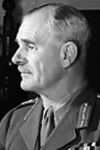I Was There! - I Saw a Marine Corporal Firing to the Last
The War Illustrated, Volume 4, No. 96, Page 671, July 4, 1941.
The magnificent work of the Royal Marines in Crete earned special recognition fro General Wavell, A typical exploit was told below of Lance-Corporal Thomas Neill, who kept his Bofors gun firing to the last.
During the withdrawal from Suda Bay the Royal Marines formed the rearguard, and some of them manned the anti-aircraft defences. On reaching Egypt, Marine Patrick Mahoney of Liverpool told this story. He said:
From the moment the Nazis started the attack on Canea, Lance-Corporal Neill, with three companions helping to operate an A.A. gun and two others passing ammunition, fired almost continuously.
Each time a group of Nazi dive-bombers came over us, Neill would let all but the last plane pass before opening fire, concentrating on that one. To my knowledge, he got nine within two days, and at least 20 within a fortnight.
Heroic Marines in Crete
General Wavell to General Weston, of the Royal Marines, May 31:
You know the heroic effort the Navy has made to rescue you. I hope you will be able to get away most of those who remain, but this is the last night the Navy can come. Please tell those that have to be left that the fight put up against such odds has won the admiration of us all, and every effort to bring them back is being made. General Freyberg has told me how magnificently your Marines have fought, and of your own grand work. I have heard also of the heroic fight of young Greek soldiers. I send you all my grateful thanks.
The Nazis soon learned Neill's strategy, so they decided to get him by trickery. They kept sending over 10 to 20 planes, but behind this group three more.
Neill took his usual shots at the last machine in the first formation, and the following three planes plastered his position repeatedly with sticks of heavy bombs. But they failed to get him.
He countered the Nazi trick by some fast thinking, went on Mahoney. He attached his gun to a light lorry. Immediately after firing at the last plane of each group of bombers, he hopped on the lorry and moved the gun to a new position.
The German bombs kept bursting away on positions Neill had just left. His gun, camouflaged with brush, was kept in action continuously. On one occasion it shot down two out of ten bombers.
Mahoney concluded: I last saw Neill near Canea on May 27. He was with two companions, the only survivors from a gun crew of six, against a background of blazing trees set alight by a petrol dump which was blown up by the dive-bombers.
He was singing and shouting as he blazed away at the swooping planes. I hope he got away safely. (B.U.P.)
Previous and next article from I Was There!
I Was There! - We Fired the Torpedoes that Finished Her
When the chase of the Bismarck was ended and her guns were silenced, she still had to be sunk by torpedoes from the cruiser Dorsetshire, and here is the story of Lieut.-Commander G. R. Carver who fire
I Was There! - For Days We Fought the Nazi Parachutists
How our troops in Crete tackled the Germans on the ground but were overwhelmed by their bombing planes is vividly described in this account of the fighting by a wounded Maori sergeant. On the after
Index
Previous article
I Was There! - We Fired the Torpedoes that Finished Her
When the chase of the Bismarck was ended and her guns were silenced, she still had to be sunk by torpedoes from the cruiser Dorsetshire, and here is the story of Lieut.-Commander G. R. Carver who fire
Next article
A Prayer for the People in Invasion
Lord, make me worthy of this land, My richest dower, And grant me courage to withstand The testing hour. Strengthen my faith, that I may see In Hope's clear light The Victory, if Calvary Shou




